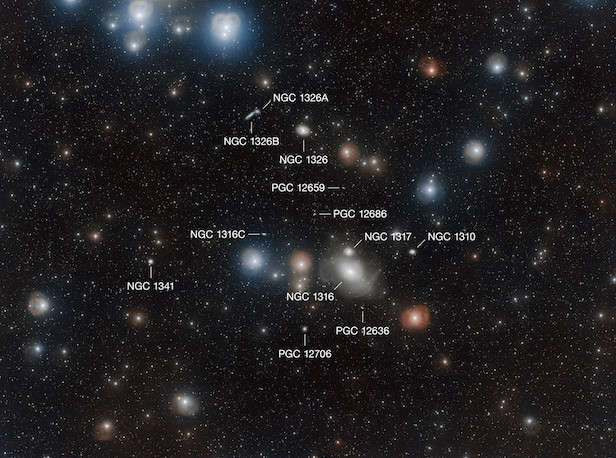Astronomers capture great galaxy cluster with stunning new clarity
Galactic member NGC 1316 has been found to be a goldmine of information

The Fornax Galaxy Cluster, which lies 60 light-years away, is one of the richest and closest galaxy clusters to the Milky Way. Image credit: ESO/ A. Grado & L. Limatola
The European Southern Observatory (ESO)’s VLT Survey Telescope has captured a fantastic image of the Fornax Galaxy Cluster, which includes a stunning array of galaxies of all shapes and colours. Amongst the galactic army is a special galaxy named NGC 1316, and its immersive past has created an exciting formation of loops, arcs and rings that astronomers have now imaged in greater detail then ever before.
The original image is one of the largest images that ESO has every released, as it consists of an outstanding 2.3-gigapixels. This was taken as part of the Fornax Deep Survey, which is a survey dedicated to uncovering the secrets of the Fornax system. But out of all of the structures within this picture, one rises above the rest, and that’s the lenticular galaxy NGC 1316. A lenticular galaxy is the intermediate between spiral and elliptical galaxies, and is thought that they formed by mergers of smaller galaxies. This is believed to be the case for NGC 1316, as the gravitational distortion of multiple, small galactic mergers have created the unusual lenticular shape we see before us.
The mergers that formed the galaxy also led to an influx of gas fuelling the supermassive black hole that sits at the centre of NGC 1316. With a mass roughly 150 times the mass of our Sun, the supermassive black hole continued to accrete mass in its past until it released a powerful jet of high-energy particles. This emission is best known as ‘radio lobes’, as they can only be seen in the radio wavelength of the electromagnetic spectrum, and they are emitted perpendicular to the galactic disc. This event caused NGC 1316 to be the fourth-brightest radio source ever discovered in the sky.
Throughout years of observations, there have been four recorded type 1a supernovae within NGC 1316, and these are rare and important events used for measuring distances around the universe. Not only is a supernova extraordinarily bright, but also their luminosities stay constant throughout the universe. Because of this, astronomers can use type 1a supernovae as a ‘standard candle’, and that’s how they deduced that NGC 1316 is 60 million light years away from us. The supernova standard candle was the technique also used in the work that showed the universe expanding at an accelerating rate.
Keep up to date with the latest reviews in All About Space – available every month for just £4.99. Alternatively you can subscribe here for a fraction of the price!




